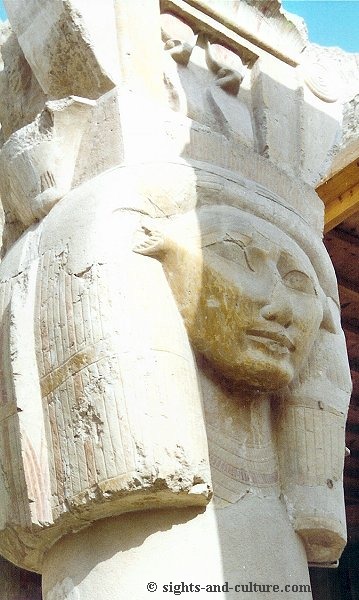The New Kingdom
1570-1000 BC
In 1550 BC, the native Egyptians won against the Hyksos. This set the stage for a new Egyptian-ruled age. During the New Kingdom, the Egyptians dominated the area with the technology from the Hyksos. They conquered the Levant—all the way to the banks of the Euphrates. But conflicts with the Hittites led to the decline of the New Kingdom and Ancient Egypt.
Some Important People from the New Kingdom...

Akhenaton reigned from 1375-1358. He was known as “the Heretic King” because he was very ahead of his time. He preached and followed gospel of perfect love, brotherhood and truth. He taught monotheism, though polytheism was the central religion of Egypt.
A statue of Akhenaton
 When Hatshepsut's husband and half-brother, the Pharaoh Thutmose II, died suddenly, Hatshepsut’s stepson, Thutmose III, inherited the throne. But Thutmose III was too young, so Hatshepsut served as a regent. A few years later, Hatshepsut crowns herself pharaoh alongside her stepson. As a pharaoh, she encouraged trade and sponsored expedition to Punt. She also added to temples (Amun at Karnak and her own memorial temple—though Thutmose III attacked her memory after her death)
When Hatshepsut's husband and half-brother, the Pharaoh Thutmose II, died suddenly, Hatshepsut’s stepson, Thutmose III, inherited the throne. But Thutmose III was too young, so Hatshepsut served as a regent. A few years later, Hatshepsut crowns herself pharaoh alongside her stepson. As a pharaoh, she encouraged trade and sponsored expedition to Punt. She also added to temples (Amun at Karnak and her own memorial temple—though Thutmose III attacked her memory after her death)
Part of a mortual temple of Hatshepsut
Ramses II, or Ramses the Great, came to power at the age of 25. He is most renowned for building great monuments and warring with the Hittites for 16 years. He had 100 sons and eight “principle wives.” He may have been the pharaoh of the Exodus. He ruled for 67 years before dying when he was 92.

The mummy of Ramses II
Go Back
Images courtesy of:
http://www.egyptarchive.co.uk/images/cairo_museum/33_akhenaten_large.jpg
http://www.crb2.k12.wy.us/users/pkraft/egypt/Ramses%20II%20mummy.jpg
http://www.sights-and-culture.com/Egypt/Hatshepsut-sc.jpg
 When Hatshepsut's husband and half-brother, the Pharaoh Thutmose II, died suddenly, Hatshepsut’s stepson, Thutmose III, inherited the throne. But Thutmose III was too young, so Hatshepsut served as a regent. A few years later, Hatshepsut crowns herself pharaoh alongside her stepson. As a pharaoh, she encouraged trade and sponsored expedition to Punt. She also added to temples (Amun at Karnak and her own memorial temple—though Thutmose III attacked her memory after her death)
When Hatshepsut's husband and half-brother, the Pharaoh Thutmose II, died suddenly, Hatshepsut’s stepson, Thutmose III, inherited the throne. But Thutmose III was too young, so Hatshepsut served as a regent. A few years later, Hatshepsut crowns herself pharaoh alongside her stepson. As a pharaoh, she encouraged trade and sponsored expedition to Punt. She also added to temples (Amun at Karnak and her own memorial temple—though Thutmose III attacked her memory after her death)

